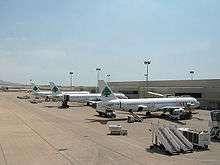Transport in Lebanon
Transportation in Lebanon varies greatly in quality from the ultramodern Beirut International Airport to poor road conditions in many parts of the country. The Lebanese civil war between 1975 and 1990 and the 2006 Lebanon War with Israel severely damaged the country's infrastructure.
Roads
Lebanon has an extensive road network throughout the country, generally in good conditions, though it varies. The main roads in the country are:
- Beirut - Byblos - Tripoli - Aarida
- Beirut - Sidon - Sour - Naqoura
- Beirut - Bhamdoun Al Mhatta - Chtaura - Masnaa
- Chtaura - Zahle - Baalbek - Qaa
- Tripoli - Bcharre - Baalbek
Motorways
Part of the main road network have been updated to dual carriageway, four-lane motorways, which are the following:
- Beirut - Tripoli. Length: 81 km.
- Beirut - Kfar Badde. Length: 65 km.
- Beirut - Sofar. Length: 26 km.
- Tripoli - Khane. Length: 20 km.
Buses
An overland trans-desert bus service between Beirut, Haifa, Damascus and Baghdad was established by the Nairn Transport Company of Damascus in 1923.
Beirut has frequent bus connections to other cities in Lebanon and major cities in Syria. The Lebanese Commuting Company, or LCC in short, is just one of a handful brands of public transportations all over Lebanon.[1] On the other hand, the publicly owned buses are managed by le Office des Chemins de Fer et des Transports en Commun (OCFTC), or the "Railway and Public Transportation Authority" in English.[2] Buses for northern destinations and Syria leave from Charles Helou Station.[3]
Buses are popular and inexpensive and can be stopped anywhere along the way simply by hailing. Never take a bus without verifying the destination with the driver. The fair is for LBP1500 ($1). There are Public Buses (are not regular) and Private Buses (are in general better organized than Public buses).
Ferries
Apart from the international airport, the Port of Beirut is another port of entry. As a final destination, anyone can also reach Lebanon by ferry from Cyprus or by road from Damascus.[4] The Port of Tripoli (Lebanon) is also a port of entry.
Taxis and services
Apart from buses, the latter are served by either service or taxis. 'Service' is a lot cheaper than taxis however, to avoid misunderstanding, agreement over the pricing needs to be made before setting off.[4]
Note: Meters are NOT used in Lebanon. Prices for Taxis must be negotiated before entering the vehicle.
Service-taxis are probably the most popular means of transportation in Lebanon and recognizable by their red plate. You can take a service or taxi just by hailing in the street. Watch out, if there are no passengers, specify if you would like it as a “taxi” (private cab) or as a “service” (shared cab).
Types of taxis in Lebanon
- Service-taxis
One has to specify one's destination and enter the taxi only if one's destination corresponds to the itinerary of the Service-taxi. The driver stops to pick up additional passengers anywhere on the streets and drop them off generally in main squares and main streets. It remains advantageous with very low fares.
Service-Taxi Taxi
- Local
- LBP 2000 ($1.32) per person or LBP 4000 ($2.64) per person depending on how close/far the destination is. All prices within Beirut should not exceed LBP 4000 per person (Maximum of LBP 5000 for Beirut outskirts). (Note: If the driver says 'Servicene', he means double the 'Service' price, i.e. LBP 4000 per person).
- Long Distance
- LBP 5.000 ($3.50) LP 30.000 ($20)
- Traditional Taxis
The driver must not pick up additional passengers. Most of these taxis are not equipped with meters, so negotiate the fare before embarking. The estimation of the fare is therefore often an approximate.
- On-call taxis
Pick up people who have pre-booked by phone. They don’t respond to hails in the street. They don’t have a meter so passengers should ask the operator the price when they are booking the taxi, and double check with the driver at the end of the journey.
Trains
The Lebanese rail system is not currently in use, with services having ceased due to the country's political difficulties.
Port infrastructure
Airport
The main national airport is the Beirut Rafic Hariri International Airport and is located in the southern suburbs. The Travel and Tourism Competitiveness report ranked the country 51st in terms of air transport infrastructure.[5]}
Other
An aerial tramway (Téléphérique) operates in the Jounieh area and the Beirut Tramway was decommissioned in 1968.
See also
References
- ↑ http://www.lccworld.com/profile.asp Company Profile], LCC
- ↑ OCFTC
- ↑ Beirut Transport, Lonely Planet
- 1 2 Transportation & Communication, Ikama
- ↑ History Beirut Rafic Hariri International Airport
External links
![]() Media related to Transport in Lebanon at Wikimedia Commons
Media related to Transport in Lebanon at Wikimedia Commons
